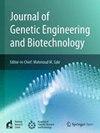Integrative bioinformatics and deep learning to identify common genetic pathways in Crohn’s disease and ischemic cardiomyopathy
IF 2.8
Q3 Biochemistry, Genetics and Molecular Biology
Journal of Genetic Engineering and Biotechnology
Pub Date : 2025-06-26
DOI:10.1016/j.jgeb.2025.100529
引用次数: 0
Abstract
Crohn’s disease (CD) and ischemic cardiomyopathy (ICM) share inflammatory characteristics, yet their common genetic underpinnings remain underexplored. Using an integrative bioinformatics approach, we analyzed GEO datasets (GSE3365 and GSE9128) to identify shared genetic pathways between CD and ICM. Through differential expression analysis, we identified 60 common differentially expressed genes (CDEGs). Functional enrichment analysis revealed enrichment in inflammatory pathways, including NF-κB and TNF-α signaling, highlighting their role in disease pathogenesis. We conducted microRNA (miRNA), transcription factor (TF), and protein–protein interaction (PPI) analyses to uncover regulatory networks. Notably, hsa-miR-98-5p emerged as a key miRNA, while RELA and NFKB1 were identified as prominent TFs interacting with CDEGs. Six hub genes—IL1B, CXCL8, CXCL2, TLR2, FCGR1A, and FCGR2A—were pinpointed, demonstrating high diagnostic potential via receiver operating characteristic (ROC) analysis. To advance diagnostic precision, we developed AutoClass, a deep learning framework that leverages hub gene regulatory networks to classify CD patients with approximately 95 % accuracy. These hub genes and regulators likely drive neutrophil-mediated inflammation, offering insights into the molecular interplay between CD and ICM. Our findings suggest that the identified CDEGs, miRNAs, and TFs hold promise as therapeutic targets and biomarkers, paving the way for precision medicine approaches in managing CD and its cardiovascular complications. Future experimental validation and cohort expansion could further elucidate these shared mechanisms, enhancing their translational impact.
综合生物信息学和深度学习识别克罗恩病和缺血性心肌病的共同遗传途径
克罗恩病(CD)和缺血性心肌病(ICM)具有共同的炎症特征,但它们共同的遗传基础仍未得到充分研究。利用综合生物信息学方法,我们分析了GEO数据集(GSE3365和GSE9128),以确定CD和ICM之间的共享遗传途径。通过差异表达分析,我们鉴定了60个常见差异表达基因(cdeg)。功能富集分析显示炎症通路富集,包括NF-κB和TNF-α信号,突出了它们在疾病发病机制中的作用。我们进行了microRNA (miRNA)、转录因子(TF)和蛋白-蛋白相互作用(PPI)分析,以揭示调控网络。值得注意的是,hsa-miR-98-5p成为关键miRNA,而RELA和NFKB1被确定为与cdeg相互作用的重要tf。通过受试者工作特征(ROC)分析,确定了6个枢纽基因——il1b、CXCL8、CXCL2、TLR2、FCGR1A和fcgr2a,显示出很高的诊断潜力。为了提高诊断精度,我们开发了AutoClass,这是一个深度学习框架,利用枢纽基因调控网络对CD患者进行分类,准确率约为95%。这些中心基因和调节因子可能驱动中性粒细胞介导的炎症,为CD和ICM之间的分子相互作用提供了见解。我们的研究结果表明,已鉴定的cdeg、mirna和TFs有望成为治疗靶点和生物标志物,为精准医学方法治疗CD及其心血管并发症铺平道路。未来的实验验证和队列扩展可以进一步阐明这些共同的机制,增强它们的转化影响。
本文章由计算机程序翻译,如有差异,请以英文原文为准。
求助全文
约1分钟内获得全文
求助全文
来源期刊

Journal of Genetic Engineering and Biotechnology
Biochemistry, Genetics and Molecular Biology-Biotechnology
CiteScore
5.70
自引率
5.70%
发文量
159
审稿时长
16 weeks
期刊介绍:
Journal of genetic engineering and biotechnology is devoted to rapid publication of full-length research papers that leads to significant contribution in advancing knowledge in genetic engineering and biotechnology and provide novel perspectives in this research area. JGEB includes all major themes related to genetic engineering and recombinant DNA. The area of interest of JGEB includes but not restricted to: •Plant genetics •Animal genetics •Bacterial enzymes •Agricultural Biotechnology, •Biochemistry, •Biophysics, •Bioinformatics, •Environmental Biotechnology, •Industrial Biotechnology, •Microbial biotechnology, •Medical Biotechnology, •Bioenergy, Biosafety, •Biosecurity, •Bioethics, •GMOS, •Genomic, •Proteomic JGEB accepts
 求助内容:
求助内容: 应助结果提醒方式:
应助结果提醒方式:


